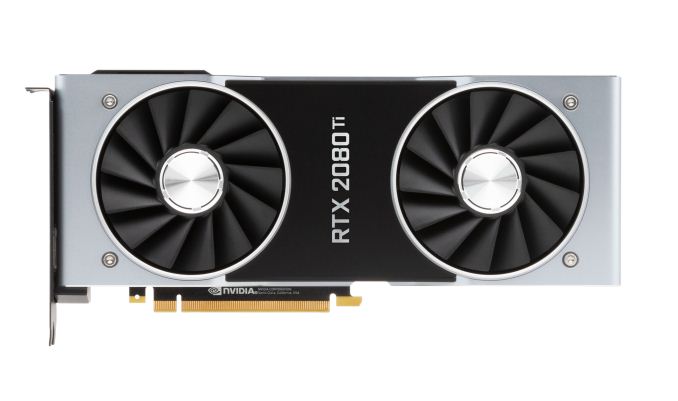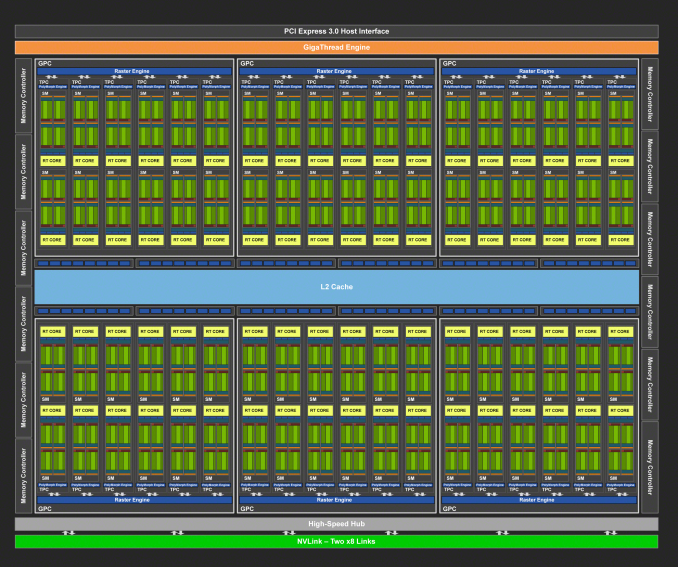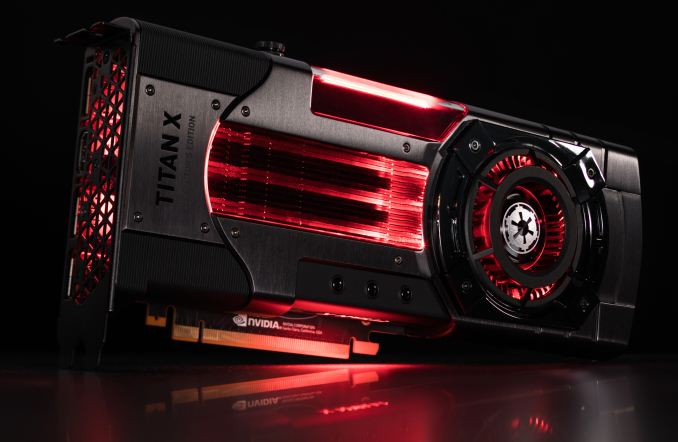The NVIDIA GeForce RTX 2080 Ti & RTX 2080 Founders Edition Review: Foundations For A Ray Traced Future
by Nate Oh on September 19, 2018 5:15 PM EST- Posted in
- GPUs
- Raytrace
- GeForce
- NVIDIA
- DirectX Raytracing
- Turing
- GeForce RTX

While it was roughly 2 years from Maxwell 2 to Pascal, the journey to Turing has felt much longer despite a similar 2 year gap. There’s some truth to the feeling: looking at the past couple years, there’s been basically every other possible development in the GPU space except next-generation gaming video cards, like Intel’s planned return to discrete graphics, NVIDIA’s Volta, and cryptomining-specific cards. Finally, at Gamescom 2018, NVIDIA announced the GeForce RTX 20 series, built on TSMC’s 12nm “FFN” process and powered by the Turing GPU architecture. Launching today with full general availability is just the GeForce RTX 2080, as the GeForce RTX 2080 Ti was delayed a week to the 27th, while the GeForce RTX 2070 is due in October. So up for review today is the GeForce RTX 2080 Ti and GeForce RTX 2080.
But a standard new generation of gaming GPUs this is not. The “GeForce RTX” brand, ousting the long-lived “GeForce GTX” moniker in favor of their announced “RTX technology” for real time ray tracing, aptly underlines NVIDIA’s new vision for the video card future. Like we saw last Friday, Turing and the GeForce RTX 20 series are designed around a set of specialized low-level hardware features and an intertwined ecosystem of supporting software currently in development. The central goal is a long-held dream of computer graphics researchers and engineers alike – real time ray tracing – and NVIDIA is aiming to bring that to gamers with their new cards, and willing to break some traditions on the way.
| NVIDIA GeForce Specification Comparison | ||||||
| RTX 2080 Ti | RTX 2080 | RTX 2070 | GTX 1080 | |||
| CUDA Cores | 4352 | 2944 | 2304 | 2560 | ||
| Core Clock | 1350MHz | 1515MHz | 1410MHz | 1607MHz | ||
| Boost Clock | 1545MHz FE: 1635MHz |
1710MHz FE: 1800MHz |
1620MHz FE: 1710MHz |
1733MHz | ||
| Memory Clock | 14Gbps GDDR6 | 14Gbps GDDR6 | 14Gbps GDDR6 | 10Gbps GDDR5X | ||
| Memory Bus Width | 352-bit | 256-bit | 256-bit | 256-bit | ||
| VRAM | 11GB | 8GB | 8GB | 8GB | ||
| Single Precision Perf. | 13.4 TFLOPs | 10.1 TFLOPs | 7.5 TFLOPs | 8.9 TFLOPs | ||
| Tensor Perf. (INT4) | 430TOPs | 322TOPs | 238TOPs | N/A | ||
| Ray Perf. | 10 GRays/s | 8 GRays/s | 6 GRays/s | N/A | ||
| "RTX-OPS" | 78T | 60T | 45T | N/A | ||
| TDP | 250W FE: 260W |
215W FE: 225W |
175W FE: 185W |
180W | ||
| GPU | TU102 | TU104 | TU106 | GP104 | ||
| Transistor Count | 18.6B | 13.6B | 10.8B | 7.2B | ||
| Architecture | Turing | Turing | Turing | Pascal | ||
| Manufacturing Process | TSMC 12nm "FFN" | TSMC 12nm "FFN" | TSMC 12nm "FFN" | TSMC 16nm | ||
| Launch Date | 09/27/2018 | 09/20/2018 | 10/2018 | 05/27/2016 | ||
| Launch Price | MSRP: $999 Founders $1199 |
MSRP: $699 Founders $799 |
MSRP: $499 Founders $599 |
MSRP: $599 Founders $699 |
||
As we discussed at the announcement, one of the major breaks is that NVIDIA is introducing GeForce RTX as the full upper tier stack with x80 Ti/x80/x70 stack, where it has previously tended towards the x80/x70 products first, and the x80 Ti as a mid-cycle refresh or competitive response. More intriguingly, each GeForce card has their own distinct GPU (TU102, TU104, and TU106), with direct Quadro and now Tesla variants of TU102 and TU104. While we covered the Turing architecture in the preceding article, the takeaway is that each chip is proportionally cut-down, including the specialized RT Cores and Tensor Cores; with clockspeeds roughly the same as Pascal, architectural changes and efficiency enhancements will be largely responsible for performance gains, along with the greater bandwidth of 14Gbps GDDR6.
And as far as we know, Turing technically did not trickle down from a bigger compute chip a la GP100, though at the architectural level it is strikingly similar to Volta/GV100. Die size brings more color to the story, because with TU106 at 454mm2, the smallest of the bunch is frankly humungous for a FinFET die nominally dedicated for a x70 GeForce product, and comparable in size to the 471mm2 GP102 inside the GTX 1080 Ti and Pascal Titans. Even excluding the cost and size of enabled RT Cores and Tensor Cores, a slab of FinFET silicon that large is unlikely to be packaged and priced like the popular $330 GTX 970 and still provide the margins NVIDIA is pursuing.
These observations are not so much to be pedantic, but more so to sketch out GeForce Turing’s positioning in relation to Pascal. Having separate GPUs for each model is the most expensive approach in terms of research and development, testing, validation, extra needed fab tooling/capacity – the list goes on. And it raises interesting questions on the matter of binning, yields, and salvage parts. Though NVIDIA certainly has the spare funds to go this route, there’s surely a better explanation than Turing being primarily designed for a premium-priced consumer product that cannot command the margins of professional parts. These all point to the known Turing GPUs as oriented for lower-volume, and NVIDIA’s financial quarterly reports indicate that GeForce product volume is a significant factor, not just ASP.
And on that note, the ‘reference’ Founders Edition models are no longer reference; the GeForce RTX 2080 Ti, 2080, and 2070 Founders Editions feature 90MHz factory overclocks and 10W higher TDP, and NVIDIA does not plan to productize a reference card themselves. But arguably the biggest change is the move from blower-style coolers with a radial fan to an open air cooler with dual axial fans. The switch in design improves cooling capacity and lowers noise, but with the drawback that the card can no longer guarantee that it can cool itself. Because the open air design re-circulates the hot air back into the chassis, it is ultimately up to the chassis to properly exhaust the heat. In contrast, a blower pushes all the hot air through the back of the card and directly out of the case, regardless of the chassis airflow or case fans.
All-in-all, NVIDIA is keeping the Founders Edition premium, which is now $200 over the baseline ‘reference.’ Though AIB partner cards are also launching today, in practice the Founders Edition pricing is effectively the retail price until the launch rush has subsided.
The GeForce RTX 20 Series Competition: The GeForce GTX 10 Series
In the end, the preceding GeForce GTX 10 series ended up occupying an odd spot in the competitive landscape. After its arrival in mid-2016, only the lower end of the stack had direct competition, due to AMD’s solely mainstream/entry Polaris-based Radeon RX 400 series. AMD’s RX 500 series refresh in April 2017 didn’t fundamentally change that, and it was only until August 2017 that the higher-end Pascal parts had direct competition with their generational equal in RX Vega. But by that time, the GTX 1080 Ti (not to mention the Pascal Titans) was unchallenged. And all the while, an Ethereum-led resurgence of mining cryptocurrency on video cards was wreaking havoc on GPU pricing and inventory, first on Polaris products, then general mainstream parts, and finally affecting any and all GPUs.
Not that NVIDIA sat on their laurels with Vega, releasing the GTX 1070 Ti anyhow. But what was constant was how the pricing models evolved with the Founders Editions schema, the $1200 Titan X (Pascal), and then $700 GTX 1080 Ti and $1200 Titan Xp. Even the $3000 Titan V maintained gaming cred despite diverging greatly from previous Titan cards as firmly on the professional side of prosumer, basically allowing the product to capture both prosumers and price-no-object enthusiasts. Ultimately, these instances coincided with the rampant cryptomining price inflation and was mostly subsumed by it.
So the higher end of gaming video cards has been Pascal competing with itself and moving up the price brackets. For Turing, the GTX 1080 Ti has become the closest competitor. RX Vega performance hasn’t fundamentally changed, and the fallout appears to have snuffed out any Vega 10 parts, as well as Vega 14nm+ (i.e. 12nm) refreshes. As a competitive response, AMD doesn’t have many cards up their sleeves except the ones already played – game bundles (such as the current “Raise the Game” promotion), FreeSync/FreeSync 2, other hardware (CPU, APU, motherboard) bundles. Other than that, there’s a DXR driver in the works and a machine learning 7nm Vega on the horizon, but not much else is known, such as mobile discrete Vega. For AMD graphics cards on shelves right now, RX Vega is still hampered by high prices and low inventory/selection, remnants of cryptomining.
For the GeForce RTX 2080 Ti and 2080, NVIDIA would like to sell you the RTX cards as your next upgrade regardless of what card you may have now, essentially because no other card can do what Turing’s features enable: real time raytracing effects ((and applied deep learning) in games. And because real time ray tracing offers graphical realism beyond what rasterization can muster, it’s not comparable to an older but still performant card. Unfortunately, none of those games have support for Turing’s features today, and may not for some time. Of course, NVIDIA maintains that the cards will provide expected top-tier performance in traditional gaming. Either way, while Founders Editions are fixed at their premium MSRP, custom cards are unsurprisingly listed at those same Founders Edition price points or higher.
| Fall 2018 GPU Pricing Comparison | |||||
| AMD | Price | NVIDIA | |||
| $1199 | GeForce RTX 2080 Ti | ||||
| $799 | GeForce RTX 2080 | ||||
| $709 | GeForce GTX 1080 Ti | ||||
| Radeon RX Vega 64 | $569 | ||||
| Radeon RX Vega 56 | $489 | GeForce GTX 1080 | |||
| $449 | GeForce GTX 1070 Ti | ||||
| $399 | GeForce GTX 1070 | ||||
| Radeon RX 580 (8GB) | $269/$279 | GeForce GTX 1060 6GB (1280 cores) |
|||













337 Comments
View All Comments
Santoval - Wednesday, September 19, 2018 - link
The problem is that it does not bring those things to the current table but is going to bring them to a future table. Essentially they expect you to buy a graphics cards that no current game can support its advanced features merely on faith that it both will deliver them in the future *and* that they will be will be worth the very high premium.If there is one ultimate unwritten rule when buying computers, computer parts or anything really, it must be this one : Never buy anything based on promises of *future* capabilities - always make your purchasing decisions based on what the products you buy can deliver *now*. All experienced computer and console consumers, in particular, must have that maxim engraved on their brain after having been burnt by so many broken promises.
Writer's Block - Monday, October 1, 2018 - link
That is certainly true; 'we promise', politicians and companies selling their shit use it a lot... And break it about as often.Inteli - Wednesday, September 19, 2018 - link
It's not that the price increase wasn't warranted, at least from the transistor count perspective, it's that there's not a lot to show for it.Many more transistors...concentrated in Tensor cores and RTX cores, which aren't being touched in current games. The increased price is for a load of baggage that will take at least a year to really get used (and before you say it, 3 games is not "really getting used"). We're used to new GPUs performing better in current games for the same price, not performing the same in current games for the same price (and I'm absolutely discounting everything before 2008 because that was 10 years ago and the expectations of what a new μArch should bring have changed).
I get the whole "future of gaming" angle you're pushing, and it's a perfectly valid reason to buy these new GPUs, but don't act like an apples-to-apples comparison of performance *right now* is the "wrong way of looking at it". How the card performs right now is an important metric for a lot of people, and will influence their decision. Especially when we're talking a potential price difference of $100+ (with sales on 1080 Ti's, and FE 2080 prices). Obviously there isn't a valid comparison for the 2080 Ti, but anyone who can drop $1300 on a GPU probably doesn't care too much about the price tag.
Flunk - Thursday, September 20, 2018 - link
Nvidia is charging what they are because they have no competition at the top end. That's it, nothing else. They're taking in the cash today in preparation for having to price more competitively later.just4U - Thursday, September 20, 2018 - link
Flunk, we are talking Nvidia here.. typically speaking they don't lower prices to compete.. Sometimes they bump to high and to few bite.. but that's about it. The last time they lowered prices to compete was the 400 series but they'd just come off getting zonked by amd for basically 2 generations.. and when they went to the 500s series it was fairly competitive with amd.. (initially they were better but Amd continued to improve their 5000/6000 series.. til it was consistently beating Nvidia.. did they lower prices? NO.. not one bit..)TNT cards were competitive and cheap.. but once Nvidia knocked off all other contenders (aside from AMD) and started in with their geforce line they have always carried premiums regardless competition or not.
eddman - Thursday, September 20, 2018 - link
GTX 280, launched at $650 because they thought AMD couldn't do much. AMD came up with 4870. What happened? Nvidia cut the card's price to $500 a mere month after launch. So yes, they do cut prices to compete.Dragonstongue - Thursday, September 20, 2018 - link
13.6 and 18.6 (bln transistor estimated) die size of 454/754mm2 (2080/2080Ti) 12nm7.2 and 12 (bln transistor estimated) die size of 314/471 (1070/1080-1080Ti/TitanX) 16nm
yes it is "expensive" no doubt about that, but, it is Nv we are talking about, there is a reason they are way over valued as they are, they produce as cheaply as possible and rack them up in price as much as they can even when their actual cards shipped are no where near the $$$ figure they report as it should.
also, if anything else, they always have and always will BS the numbers to make themselves ALWAYS appear "supreme" no matter if it is actual power used, TDP, API features, or transistor count etc etc etc.
as far as the ray tracing crap...if they used an open source style so that everyone can use the exact same ray tracing engine so they can be directly compared to see how good they are or not then it might be "worthy" but, it is Nv they are and continue to be "it has to be our way or you don't play" type approach...I remember way back when with PhysX (which Nv boug out Ageia to do it) when Radeons were able to use it (before Nv took the ability away) they ran circles around comparable Nv cards AND used less cpu and power to do it.
Nv does not want to get "caught" in their BS, so they find nefarious ways around everything, and when you have a massive amount of $$$$$$$$$$$$$$$$ floating everything you do, it is not hard for them to "buy silence" Intel has done so time and time again, Nv does so time and time again........blekk
DLSS or whatever the fk they want to call it, means jack shit when only specific cards will be able to use it instead of being a truly open source initiative where everyone/everything gets to show how good they are (or not) and also stand to gain benefit from others putting effort into making it as good as it possibly can be...there is a reason why Nv barely supports Vulkan, because they are not "in control" it is way too easy to "prove them wrong"..funny because Vulkan has ray tracing "built in"
IMO if they are as good as they claim they are, they would do everything in the light to show they are "the best" not find ways to "hide" what they are doing.....their days are numbered....hell their stock price just took a hit....good IMHO because they should not be over $200 anyways, $100, maybe, but they absolutely should not be valued above others whos financials and product shipment as magnitudes larger.
Spunjji - Friday, September 21, 2018 - link
Remind me why consumers should give a rats-ass about die size, other than its visible effects of price and performance.If you want to sell me a substantially larger, more expensive chip that performs a little better for a lot more money, a better reason is needed than "maybe it will make some games that aren't out yet really cool in a way that we refuse to give you any performance indications about".
Screw that.
Writer's Block - Monday, October 1, 2018 - link
They look poor value; good performance, sure. But a 1080ti offers the same for much less.They want me to buy promises! Seriously, promises are never worth the paper they are printed on - digital or the real stuff.
Writer's Block - Monday, October 1, 2018 - link
Oh and, yeh agree.